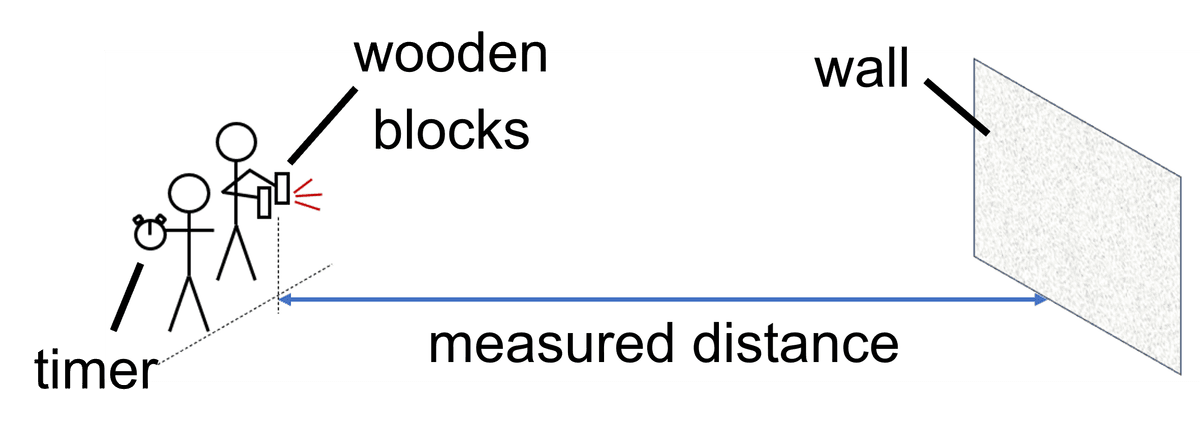Myths about teaching can hold you back
- Year 9
- Year 9
Speed of sound
I can measure the speed of sound waves in air using an echo method.
These resources will be removed by end of Summer Term 2025.
Switch to our new teaching resources now - designed by teachers and leading subject experts, and tested in classrooms.
These resources were created for remote use during the pandemic and are not designed for classroom teaching.
Lesson details
Key learning points
- The ‘speed of sound’ is the distance travelled by a sound wave pulse every second, measured in m/s.
- Sound wave speed depends on the medium: it is about 340 m/s in air, faster in liquids and faster still in solids.
- Sound waves can reflect from hard surfaces, travel back and be heard again (an echo).
- The speed of sound waves (or the distance they travel) can be calculated using the equation: speed = distance ÷ time.
- In an experiment, measuring longer distances and times means any errors are a smaller proportion of the measurements.
Keywords
Speed - how fast something is moving, often measured in metres per second
Sound wave - a ‘pulse’ that travels through a material caused by forward and backward vibrations of particles
Medium - the material through which a wave travels
Frequency - the number of vibrations each second
Echolocation - a method of detecting distances to objects by making a sound and waiting for an echo to return
Common misconception
High pitched sounds (higher frequency sound waves) travel faster than low pitched sounds (lower frequency sound waves).
Take measurements for the speed of sound using a high-pitched blast of a whistle as well as the lower pitched sound of hitting pieces of wood together to show they are the same (within error).
To help you plan your year 9 science lesson on: Speed of sound, download all teaching resources for free and adapt to suit your pupils' needs...
To help you plan your year 9 science lesson on: Speed of sound, download all teaching resources for free and adapt to suit your pupils' needs.
The starter quiz will activate and check your pupils' prior knowledge, with versions available both with and without answers in PDF format.
We use learning cycles to break down learning into key concepts or ideas linked to the learning outcome. Each learning cycle features explanations with checks for understanding and practice tasks with feedback. All of this is found in our slide decks, ready for you to download and edit. The practice tasks are also available as printable worksheets and some lessons have additional materials with extra material you might need for teaching the lesson.
The assessment exit quiz will test your pupils' understanding of the key learning points.
Our video is a tool for planning, showing how other teachers might teach the lesson, offering helpful tips, modelled explanations and inspiration for your own delivery in the classroom. Plus, you can set it as homework or revision for pupils and keep their learning on track by sharing an online pupil version of this lesson.
Explore more key stage 3 science lessons from the Waves unit, dive into the full secondary science curriculum, or learn more about lesson planning.

Equipment
a long tape measure or trundle wheel, timer, blocks of wood, whistle, a suitable outdoor space with a large distance (over 80 m) and a large, hard vertical wall
Content guidance
- Risk assessment required - equipment
Supervision
Adult supervision required
Licence
Prior knowledge starter quiz
6 Questions
Q1.A car’s speedometer shows a speed of 20 miles per hour. What does this mean?
Q2.Which of the following describes the medium of a wave?
Q3.Which of the following can describe the motion of particles in sound waves?
Q4.Which of the following can sound travel through?
Q5.Which of the following statements about the speed of sound waves in solids, liquids and gases are correct?
Q6.Which of the following is the best definition of experimental errors?
Assessment exit quiz
6 Questions
Q1.Which of the following statements are correct?
Q2.A bird is flying at a constant speed. In 3.5 s, it travels 42 m. The speed of the bird is m/s.
Q3.Two pupils use an echo method to measure the speed of sound in air. The diagram shows the arrangement. When should the pupil start and stop the timer?



